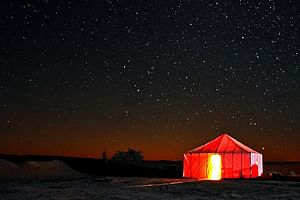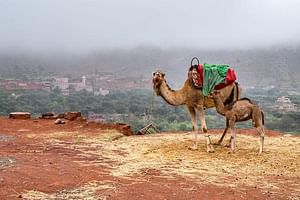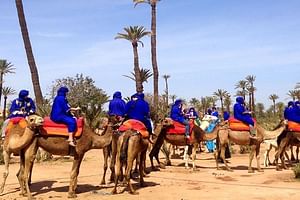Part of our revenue from this experience
will go to a charity in the region
will go to a charity in the region
Discover imperial cities and desert adventures with this 12-day circuit from Tangier in the north to Essaouira in the south. Experience culture and history of Meknes, Fes, and Marrakech as you navigate narrow and winding streets in ancient medinas, shop artisanal wares in animated souks, and admire the intricate tile work of historic mosques. Explore the desert as you ride a camel over shifting sands in the Sahara, delve into mud-brick fortressed cities, and cross the high rocky peaks of the Atlas mountains.
Duration
12 days
The tour starts at
Marrakesh, Morocco
-
Day 1
Welcome to Tangier!Welcome to Tangier! -
Day 1
Welcome to Tangier, the gateway between Europe and Africa. Lying on the Maghreb coast at the western entrance to the Strait of Gibraltar, Tangier offers a unique blend of cultures and influences that ...Welcome to Tangier, the gateway between Europe and Africa. Lying on the Maghreb coast at the western entrance to the Strait of Gibraltar, Tangier offers a unique blend of cultures and influences that have for centuries shaped the city attracting artists, spies, and eccentric foreigners. While the port city was once dismissed as being a not-so-hot place to visit, Tangier today has undergone a makeover and gleams with pride. You'll likely want to get out and explore your surroundings after checking into your hotel. Depending on your arrival time, head to the medina (old quarter) to explore the labyrinth of commercial and residential alleyways, noting the 15th-century Portuguese fortress. Find a café in the hip Zoco Chico square for something to eat and do a little people watching and cap off the day with a late afternoon paseo to enjoy the sunset as you stroll along the seafront promenade of the bustling corniche. -
Day 1
HotelHotel -
Day 2
Welcome to Tangier!Welcome to Tangier! -
Day 2
Explore Tangier and CaveBegin the day early to see more of Tangier and opt to hire a guide to take you through the kasbah (old fortification). You'll enter through the beautiful Bab Haha gate at the ...Explore Tangier and CaveBegin the day early to see more of Tangier and opt to hire a guide to take you through the kasbah (old fortification). You'll enter through the beautiful Bab Haha gate at the northeast end of Place du Mechouar and into the medina's Dar Baroud neighborhood. The kasbah is small and compact enough to allow for self-guided exploration, though a guide will offer further insight into some of the fortification's highlights. Meanwhile, just 20 minutes outside of the city, along the most northwestern point of mainland Africa, are the unique and beautiful Caves of Hercules—so named for its mythical connection to Hercules himself. Close to the mid-19th-century Cape Spartel lighthouse, you can enter the cave complex through the opening that faces the sea and resembles the shape of Africa, thought to have been created by the Phoenicians. If you’d like, you can pay for a guide to give you some additional information about the site.s of Hercules, Onward to Chefchaouen -
Day 2
HotelHotel -
Day 3
Chefchaouen to Fes, Visit the Roman Ruins of Volubilis & MeknesChefchaouen to Fes, Visit the Roman Ruins of Volubilis & Meknes -
Day 3
Rise early and you may be treated with an hour of quiet as you wander the streets in the morning. Many travelers leave in the morning, and others don't arrive until the afternoon. Use this time to sna...Rise early and you may be treated with an hour of quiet as you wander the streets in the morning. Many travelers leave in the morning, and others don't arrive until the afternoon. Use this time to snap your unobstructed photos. If you're looking to do some last-minute shopping, many shops don't open until 10 am or so. Leaving Chefchaouen behind, you'll drive toward Fes and can opt to take a short detour to explore the Roman ruins of Volubilis and the imperial city of Meknes. -
Day 3
Continue on to the smaller, less busy version of Fes, Meknes, for an optional detour and introduction to your first historic imperial city. The two main points of interest are the Ville Impériale (Im...Continue on to the smaller, less busy version of Fes, Meknes, for an optional detour and introduction to your first historic imperial city. The two main points of interest are the Ville Impériale (Imperial City) and the medina. In Ville Impériale, you can visit the Bab al-Mansour gate, the Mausoleum of Moulay Ismail, and the Royal Stables. Meanwhile, just outside of the imperial city, you may want to explore the medina—a smaller and easier to navigate version compared to Fes and Marrakech. Other than the scattered souks, you may like to visit the 14th-century Bou Inania Madrasa and the Dar Jamaï Museum, a beautiful 19th-century palace-turned-museum. -
Day 3
Continue east to your second imperial city, Fes. With its impressively large (and somewhat confusing) old medina, Fes is a city worth getting lost in. Before venturing into the medina, drive up the hi...Continue east to your second imperial city, Fes. With its impressively large (and somewhat confusing) old medina, Fes is a city worth getting lost in. Before venturing into the medina, drive up the hill to take the time to visit the Merenid Tombs located just north of the city and enjoy the all-encompassing view of historic Fes and the surrounding area. Descend the hill and find your way to your riad (a traditional Moroccan house with an interior garden) where you can enjoy a delicious meal and relax for the evening. Driving time: 4.5 hours (3.5 without stops in Volubilis and Meknes) -
Day 3
HotelHotel -
Day 4
Exploring the Imperial City & Medieval MedinaExploring the Imperial City & Medieval Medina -
Day 4
Today you'll learn about Fes, the oldest of Morocco's imperial cities and perhaps the most interesting and exciting to explore. Its medina, a UNESCO World Heritage Site, is the most complete of its ki...Today you'll learn about Fes, the oldest of Morocco's imperial cities and perhaps the most interesting and exciting to explore. Its medina, a UNESCO World Heritage Site, is the most complete of its kind in the Arab world. Because the city never experienced much colonial development, much of Fes feels like stepping back through time hundreds of years. How you tour Fes and its highlights is up to you, so consider some of these options or ask your local specialist for ideas that speak to your interests. If you're inspired by history and culture and have time to spare, you could spend a couple of days wandering the medina, visiting madrasas (Arabic for any type of educational institution), and exploring beyond the medina walls. If you have a shorter trip, a full day exploring the medina and a few highlights outside may be enough. Either way, it's recommended using an expert guide for a half-day tour to learn more about this stellar city and help you navigate the medina. -
Day 4
HotelHotel -
Day 5
FesFes -
Day 5
Fes el Bali ("Old Fes") is a great place to start your adventure. Founded in the 8th century, Moulay Idriss I welcomed refugees from Cordoba in southern Spain and Kairouan in Tunisia (both capitals of...Fes el Bali ("Old Fes") is a great place to start your adventure. Founded in the 8th century, Moulay Idriss I welcomed refugees from Cordoba in southern Spain and Kairouan in Tunisia (both capitals of western Islam at the time). Their skill in architecture and craftsmanship played a large role in the organic development of Fes over the next hundred years, creating the maze-like narrow streets. -
Day 5
HotelHotel -
Day 6
Over the Middle Atlas from Fes to Erfoud, Merzouga & the SaharaOver the Middle Atlas from Fes to Erfoud, Merzouga & the Sahara -
Day 6
Get an early start today as you'll be covering a lot of ground. From Fes, you'll travel south toward Merzouga to arrive at the Sahara dunes for a sunset camel ride. Along the way, you will drive throu...Get an early start today as you'll be covering a lot of ground. From Fes, you'll travel south toward Merzouga to arrive at the Sahara dunes for a sunset camel ride. Along the way, you will drive through the town of Azrou and climb an elevation of 7,146 feet (2,178 m) over the Col du Zad pass and through the cedar forests of the Middle Atlas mountains. Here you can enjoy sightings of the local Barbary macaque monkeys before stopping for lunch in Midelt (the 'apple city'), relishing the nearby Moulouya River and its surrounding fruit orchards. -
Day 6
Continue to Erfoud, a bustling market town known for its date festival and famous for its fossil mining and artisan factories (you may have already seen some fossils in the markets). En route, you can...Continue to Erfoud, a bustling market town known for its date festival and famous for its fossil mining and artisan factories (you may have already seen some fossils in the markets). En route, you can see hillside mines where large rocks are taken from the earth. While in town, stop at a local artisan collective where you can learn about the types of fossils found in the area and see the full process of how the fossil-rich rock is transformed into beautiful objects, large and small. -
Day 6
Near Merzouga you can take a short break and switch gears to ride a camel through the dunes to your already-prepared-for-you camp, arriving just before sunset. Climb a nearby sand dune to watch the su...Near Merzouga you can take a short break and switch gears to ride a camel through the dunes to your already-prepared-for-you camp, arriving just before sunset. Climb a nearby sand dune to watch the sunset before returning to camp for a delicious dinner, relaxing by the campfire. Enjoy an evening of Berber music followed by a night in a bedouin-style tent under an expansive night sky chock-full of unhindered twinkling stars. If four walls and modern comfort are more your style, you can opt to spend the night at a comfortable hotel/auberge in Merzouga. Driving time: 7-8 hours -
Day 6
HotelHotel -
Day 7
esert Adventures Around Merzouga, Rissani Market & Todra Gorgeesert Adventures Around Merzouga, Rissani Market & Todra Gorge -
Day 7
Wake up early to catch a spectacular desert sunrise, then spend the morning exploring more of the Sahara. You can rent a sandboard and test your skills on the dunes, take the Erg Chebbi tour (around t...Wake up early to catch a spectacular desert sunrise, then spend the morning exploring more of the Sahara. You can rent a sandboard and test your skills on the dunes, take the Erg Chebbi tour (around the dunes), join a quad ATV tour, or relax for a bit by a pool. From there, visit nearby Khemliya, a typical Saharan village (its people originally from Mali), and enjoy traditional drumming music and dancing before taking a short walk around the settlement. -
Day 7
As you leave the Merzouga region and dunes behind, stop in the market town of Rissani, entering through its impressive gate. Known for its livestock auction, it's worth your time finding the 'donkey p...As you leave the Merzouga region and dunes behind, stop in the market town of Rissani, entering through its impressive gate. Known for its livestock auction, it's worth your time finding the 'donkey parking lot' to delight your senses as well as take a walk around its traditional market. -
Day 7
Continue to Tinerhir. This desert town offers fantastic views of neighboring towns hugging the length of the extensive river oasis (30 miles or 48 km of palm trees). The surrounding desert landscape r...Continue to Tinerhir. This desert town offers fantastic views of neighboring towns hugging the length of the extensive river oasis (30 miles or 48 km of palm trees). The surrounding desert landscape reveals impressive buttes, mesas, and plateaus. Next, you'll reach today's final destination, the Todra Gorge. Almost 1000 feet (305 m) high and carved by the Todra River through red limestone, here you can enjoy a leisurely walk in and around the gorge and relax in the cool waters of the shallow river below. The rest of the evening is yours to explore or unwind. -
Day 7
HotelHotel -
Day 8
Todra Gorge to Aït Benhaddou, Stopping at Dades Valley & OuarzazateTodra Gorge to Aït Benhaddou, Stopping at Dades Valley & Ouarzazate -
Day 8
Today's journey takes you west along the Valley of a Thousand Kasbahs, many in disrepair as the kasbahs were constructed of pisé mud (rammed earth). As you head towards Aït Benhaddou, you will pass ...Today's journey takes you west along the Valley of a Thousand Kasbahs, many in disrepair as the kasbahs were constructed of pisé mud (rammed earth). As you head towards Aït Benhaddou, you will pass many small towns where you can see traditional farming methods in use. Be on the lookout for nomads tending to their animals as you make your way through Boumalne Dades, a major town and bridging point over the Dades River, and on to Kela'a M'gouna, the "Valley of the Roses." Here you can admire the cultivated rose bushes and visit a rose collective to see the process of converting rose petals into rose water and rose oil used in the cosmetic industry. -
Day 8
Next, you’ll enter the growing town of Ouarzazate, which is a common stopping point along the desert routes, as it offers a bit more accessibility than some of the nearby smaller towns, such as Ait ...Next, you’ll enter the growing town of Ouarzazate, which is a common stopping point along the desert routes, as it offers a bit more accessibility than some of the nearby smaller towns, such as Ait Benhaddou. The town was made popular by the growing movie industry, and you have an option to tour one of two movie studios if you’d like–Atlas Corporation Studios or CLA Studios–including an up-close look at some props and sets. Continue west to the desert hub and popular filming location of Ouarzazate, stopping first with a quick visit to the el Mansour resevoir—an important source of water for the local farming community. Made popular by the growing movie industry, you'll have the option to tour one of Ouarzazate's two movie studios and envision how the nearby regions have been featured in many movies. Some popular film credits include Black Hawk Down, Prometheus. -
Day 8
Next, you'll reach medieval Aït Benhaddou, Morocco's most famous kasbah and a UNESCO World Heritage Site. The old ksour dates from the 11th century when it held an important position along the trans-...Next, you'll reach medieval Aït Benhaddou, Morocco's most famous kasbah and a UNESCO World Heritage Site. The old ksour dates from the 11th century when it held an important position along the trans-Saharan trade route between Marrakech, Ouarzazate, and the southern desert. Settle into your accommodation in the old town (if you can) before setting out to wander the empty alleys and passageways in the late afternoon after the day crowds have left. -
Day 8
HotelHotel -
Day 9
Aït Benhaddou to Marrakech, Tizi n'Tichka Pass over the High AtlasAït Benhaddou to Marrakech, Tizi n'Tichka Pass over the High Atlas -
Day 9
Leave Aït Benhaddou behind to begin winding ascent over the High Atlas mountains through the Tizi n'Tichka pass. Near the top, you can enjoy sweeping vistas over the mountain range, noting its highes...Leave Aït Benhaddou behind to begin winding ascent over the High Atlas mountains through the Tizi n'Tichka pass. Near the top, you can enjoy sweeping vistas over the mountain range, noting its highest peak Mount Toubkal which clocks in at 13,671 feet (4,167 m) as well as the road ahead, which snakes down the mountainside. Stop in Taddert, the first town after the pass, and visit the Argan Oil Cooperative to learn how the local women extract the precious oil from the argan nut to make oil used in the health, food, and cosmetic industries. As you descend the High Atlas, you will notice a dramatic change in the climate and landscape as the rocks change to foothills and transition again into flat plains. Soon you will be a part of the hustle and bustle of vibrant Marrakech. -
Day 9
After a long day on the road, settle into your hotel and spend the rest of the afternoon as you like. In the early evening, Jemaa el-Fna Square comes alive with musicians, performers, snake charmers, ...After a long day on the road, settle into your hotel and spend the rest of the afternoon as you like. In the early evening, Jemaa el-Fna Square comes alive with musicians, performers, snake charmers, games, and food stalls, a catch-all of entertainment. If you want to enjoy the spectacle from a distance, choose one of the many cafés surrounding the square and enjoy a cup of mint tea and a savory meal. -
Day 9
HotelHotel -
Day 10
Marrakech: Explore the Red CityMarrakech: Explore the Red City -
Day 10
Marrakech, Morocco's second-largest metropolis, is also known as the "Red City" (due to the natural red ochre pigment in its walls). Prepare for the shock of vibrant sights, sounds, and smells as you ...Marrakech, Morocco's second-largest metropolis, is also known as the "Red City" (due to the natural red ochre pigment in its walls). Prepare for the shock of vibrant sights, sounds, and smells as you explore this bustling imperial city. To best understand the layout, orient yourself around Jemaa el-Fna. From here, you'll find the souks are to the north, the Koutoubia Mosque and Gardens to the west, and the kasbah area with the Saadian Tombs, Bahia Palace, and El Badi Palace are to the south. Until Jemaa el-Fna comes to life later in the day, you can request a guide for a half-day tour to show you the history, culture, and hidden gems of the Medina, or you can hire one of the Caliche Horse Carriages found at the southwest corner of the square -
Day 10
HotelHotel -
Day 11
Marrakech to EssaouiraMarrakech to Essaouira -
Day 11
Say goodbye to the Red City, and travel to Morocco's west coast following a route that takes you over vast rolling plains. Along the way, you'll pass through an argan tree forest, endemic to this part...Say goodbye to the Red City, and travel to Morocco's west coast following a route that takes you over vast rolling plains. Along the way, you'll pass through an argan tree forest, endemic to this part of the world. You may even see goats dining on the argan fruit, up in the tree branches. Visit an argan cooperative to learn how argan oil is extracted from the tree and what it's used for in the food and cosmetic industries. Arrive in the port city of laid-back Essaouira, a nice contrast to frenetic Marrakech, and spend the rest of the day as you choose. Walk the Skala de la Kasbah (the 18th-century seafront ramparts) along the coast. Designed by European engineers, old brass cannons line the walls and offer viewing access over the Atlantic. Explore the UNESCO-protected medina before making your way to the windswept beach. Jimi Hendrix fans may want to take a short taxi ride to Diabat at the end of Essaouira's beach, where he reportedly spent some time. -
Day 11
HotelHotel -
Day 12
Essaouira to Marrakech, DepartEssaouira to Marrakech, Depart -
Day 12
Known as the "Windy City" for its strong Alizée trade winds that hit its crescent beach, Essaouira is a popular kiteboarding destination. Take the morning to watch the windsurfers and kiteboarders or...Known as the "Windy City" for its strong Alizée trade winds that hit its crescent beach, Essaouira is a popular kiteboarding destination. Take the morning to watch the windsurfers and kiteboarders or for the more adventurous, take a lesson, before saying goodbye and returning to Marrakech. Upon arriving in Marrakech, complete any last-minute gift and souvenir shopping. Though depending on your departure details, you may wish to check out Majorelle Gardens or an alternative attraction you have yet to visit. Not far from the commotion of the medina, a visit to these lush and expansive gardens offers the perfect place to escape the afternoon heat and noise. Leave the quiet behind and bring with you your memories as you make your way home.
Dinner
Breakfast
Air-conditioned vehicle
11 Night Accommodation
Camel Ride
Breakfast
Air-conditioned vehicle
11 Night Accommodation
Camel Ride
Lunches
Gratuities
Gratuities
Featured Experiences

$58 / person
Quad Bike Marrakech
Duration: 3 hours

$549 / person
Randonnée dans désert Marocain 3jours
Duration: 3 days
© 2020 XplorPal. All Rights Reserved












